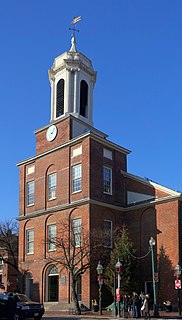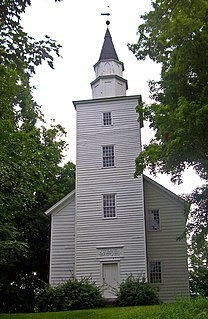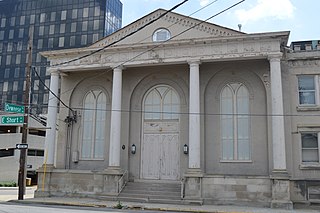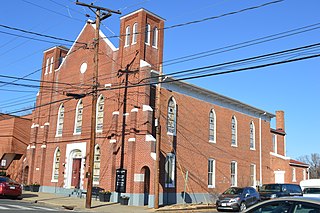
The Old South Meeting House is a historic Congregational church building located at the corner of Milk and Washington Streets in the Downtown Crossing area of Boston, Massachusetts, built in 1729. It gained fame as the organizing point for the Boston Tea Party on December 16, 1773. Five thousand or more colonists gathered at the Meeting House, the largest building in Boston at the time.

The African Meeting House, also known variously as First African Baptist Church, First Independent Baptist Church and the Belknap Street Church, was built in 1806 and is now the oldest black church edifice still standing in the United States. It is located in the Beacon Hill neighborhood of Boston, Massachusetts, adjacent to the African-American Abiel Smith School. It is a National Historic Landmark.

The Charles Street Meeting House is an early-nineteenth-century historic church in Beacon Hill at 70 Charles Street, Boston, Massachusetts.

The Ebenezer Missionary Baptist Church is a church on the National Register of Historic Places in Auburn, Alabama. Ebenezer Baptist Church was the first African American church built in the Auburn area after the end of the Civil War in 1865. Over the next few years, the church members built the church out of hand-hewn logs, transported from miles away by mules. The church was completed around 1870 and served the Ebenezer congregation until 1969. The building was restored in 1970 by the Auburn Heritage Association, and currently houses the Auburn Unitarian Universalist Fellowship.

Ebenezer, also known as New Ebenezer, is a ghost town in Effingham County, Georgia, United States, along the banks of Ebenezer Creek. It was listed on the U.S. National Register of Historic Places as Ebenezer Townsite and Jerusalem Lutheran Church in 1974.

The Primitive Baptist Church of Brookfield, also known as the Old School Baptist Meeting House, is located along US 6 in Slate Hill, New York, United States, a hamlet of the Town of Wawayanda in Orange County. It was built in 1792, when the settlement was known as Brookfield. It is one of the oldest extant church buildings in the county, and one of the earliest buildings in the settlement that became Slate Hill.

Buffalo Presbyterian Church is a historic Presbyterian Church located in Pamplin, Prince Edward County, Virginia. Built about 1804, it is a simple frame weather-boarded structure with a gable roof covered with standing seam metal. Early in the 20th century the front of the church was reoriented to the east and, in 1931, an addition was made, consisting of an entrance vestibule flanked on either side by a small classroom. Also on the property is the contributing church cemetery, with a number of stone markers, the earliest of which is dated 1832. The congregation of Buffalo was formed in 1739 and is the earliest extant Presbyterian congregation in Southside Virginia.

Old Brick Church, which is also known as Ebenezer Associate Reformed Presbyterian (ARP) Church or First Associate Reformed Presbyterian Church is a church built in 1788 about 4 mi (6 km) north of Jenkinsville on SC 213 in Fairfield County, South Carolina. It was named to the National Register of Historic Places on August 19, 1971. It is one of the few 18th-century churches surviving in the South Carolina midlands.

Springfield Baptist Church in Augusta, Georgia was built in 1801 and is a significant historical building for its architecture, religious history, and African American heritage. The congregation initially had a wood structure built and used by the Saint John Methodist Church. Since 1944, this building has been home to the Springfield Baptist congregation.

Ebenezer Particular Baptist Chapel is a former Strict Baptist place of worship in Hastings, East Sussex, England. Founded in 1817 by members of the congregation of an older Baptist chapel in the ancient town, it was extended several times in the 19th century as attendances grew during Hastings' period of rapid growth as a seaside resort. It was closed and converted into a house in the late 20th century, but still stands in a prominent position in Hastings Old Town. English Heritage has listed the building at Grade II for its architectural and historical importance.

First African Baptist Church is a historic church at 264-272 E. Short Street in Lexington, Kentucky. The congregation was founded c. 1790 by Peter Durrett and his wife, slaves who came to Kentucky with their master, Rev. Joseph Craig, in 1781 with "The Travelling Church" of Baptists from Spotsylvania, Virginia.

Ebenezer Academy, Bethany Presbyterian Church and Cemetery is a historic school building, Presbyterian church, and cemetery located six miles north of Statesville, Iredell County, North Carolina. The log building was constructed in 1823 and housed Ebenezer Academy. The church building was built about 1855, and is a one-story, three bay by five bay, vernacular Greek Revival style frame building with a low gable roof. Also on the property is the contributing church cemetery with burials dating to about 1785.

Bracken Baptist Church is a historic church on CR 1235 in Minerva, Kentucky. The Bracken Baptist Church (structure), built circa 1840–1842, is an example of prostyle Greek Revival church architecture.

Massaponax Baptist Church is an historic Southern Baptist church built in the Greek Revival style, located in Spotsylvania County, Virginia. The Baptist congregation that built the church was established in 1788 at a small church near Massaponax Creek. When that building became too small to hold the growing congregation, the church was moved to its present location at the intersection of U.S. Route 1 and State Route 608. The new church was a small, frame building which was also outgrown. In 1859, the current brick building was constructed on the site. Kilns in a nearby field fired the bricks for the exterior walls. By October 1859 the new church was completed at a cost of $3,000. Joseph Billingsly was the first pastor in the new building. An addition was built in 1949 and a brick cottage for the pastor, was built near the church in 1956. The church was listed on the National Register of Historic Places in January 1991.

Mount Moriah Baptist Church and Cemetery is a historic African-American Baptist church and cemetery located at Roanoke, Virginia. It was built about 1908, and is a small, one-story, rectangular frame church sheathed in weatherboard. It consists of a main sanctuary, a front vestibule, and a rear chancel bay. The frame building sits on a raised foundation of uncoursed fieldstones. The associated burial ground contains over 100 interments from the 1870s through the present.

The building formerly known as Park Lane Chapel is a former Strict Baptist chapel in the ancient town of Farnham in Surrey, England. Now a house, it was in religious use for nearly 150 years and housed a congregation whose origins go back to informal meetings in the 1840s. After Nisan Samuel, a Polish Jew, arrived in England and converted to Christianity, he took charge of these ad hoc meetings and formalised them into a Strict Baptist church. After he moved on, the congregation bought land and built a chapel. The small stone and brick building has been listed at Grade II for its architectural and historical importance.

The Congregational Church in Exeter was gathered in 1638 by the Rev. John Wheelwright following his expulsion from the Massachusetts Bay Colony. The current congregation is a merger of the former First Parish and Second Parish of Exeter. Second Parish split from First Parish in the 1700s during the Great Awakening over theological differences. The two congregations then reunited in 1920.

The Shiloh Baptist Church is a historic Baptist church at 810 Sophia Street in downtown Fredericksburg, Virginia. The church is a two-story brick building with predominantly Classical Revival styling, modeled to some degree after the Presbyterian Church of Fredericksburg, with later alterations. The church was built in 1890 for a predominantly African-American congregation, whose origins lie in a mixed-race Baptist congregation founded in 1804. That congregation split about 1815, worshipping in a building at this site, and became known as the Shiloh Baptist Church with the construction of a new building here in the 1830s. In 1849 the large congregation again divided, with most of its white members leaving to form the Fredericksburg Baptist Church at Princess Anne and Amelia Streets. Services were discontinued during the American Civil War, and the existing building was damaged, in part due to abuse caused during military occupation of the city. It collapsed in 1886, and the present building was constructed in 1890 as its replacement. However, due to a schism in the congregation, two separate groups claimed the name "Shiloh Baptist", which was resolved by giving the one at this location the name "Shiloh Baptist Church ", which it still retains.

The Zion Baptist Church in Marietta, Georgia is a Baptist church which was founded in 1866 by African American members of another Baptist church in the city. The current building, built in 1888, was added to the National Register of Historic Places in 1990.



























